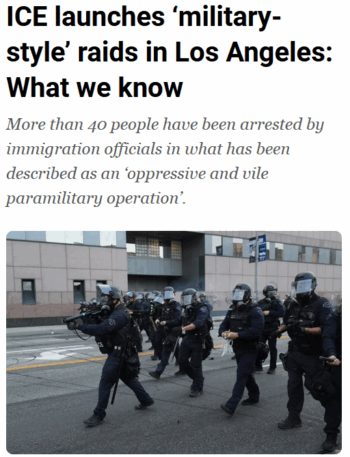
The protests emerged as resistance to militarized law enforcement (Al Jazeera, 6/7/25), a dynamic that was often obscured by coverage that focused on the “clash” between protesters and government.
In the early morning of Friday, June 6, several federal agencies carried out militarized immigration raids across Los Angeles (Al Jazeera, 6/7/25). Armed and masked Immigration and Customs Enforcement (ICE) agents, along with the Department of Homeland Security (DHS), FBI and DEA, tore through these neighborhoods in unmarked vehicles, carrying out a new method of targeted raids in workplaces like Home Depot, Ambiance Apparel and car washes (Washington Post, 6/8/25, 6/12/25, LA Times, 6/10/25).
Later that morning, demonstrations formed in front of the Edward R. Roybal Federal Building and Metropolitan Detention Center, where detainees were believed to be held (Al Jazeera, 6/11/25). Protests grew exponentially over the weekend, spreading not only across California, but also to major cities around the country (Time, 6/9/25).
In response, without state authorization, President Donald Trump federalized and deployed 2,000 California National Guard troops to LA to “solve the problem” (CNN, 6/9/25). California Gov. Gavin Newsom, LA Mayor Karen Bass and other government officials have called this an unprecedented show of force and an abuse of executive power, intended to intimidate and terrorize local communities (Atlantic, 6/10/25; CNN, 6/9/25).
‘Violence’ and ‘anarchists’
While major media sources described these protests as “mostly peaceful,” they nevertheless tended to dwell on what was depicted as rioting and protester violence. In its morning newsletter, the New York Times (6/9/25) set the scene:
Hundreds of National Guard troops arrived in the city, and crowds of people demonstrated against President Trump’s immigration raids. They clashed with federal agents, leaving burned cars, broken barricades and graffiti scrawled across government buildings downtown.
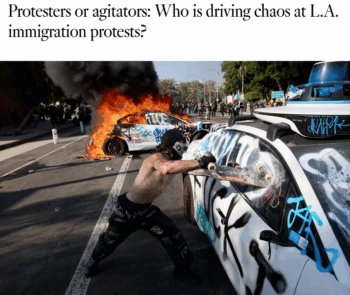
Is it possible that Trump administration efforts to expel nearly a million Los Angeles residents are “driving chaos at LA immigration protests” (LA Times, 6/10/25)?
The LA Times (6/10/25), citing LAPD Chief Jim McDonnell, blamed “‘anarchists’ who, he said, were bent on exploiting the state of unrest to vandalize property and attack police.” (Law enforcement agencies reported only a handful of minor injuries to officers—KCRA, 6/12/25.) These critiques were interwoven with descriptions of “scenes of lawlessness [that] disgusted” McDonnell, such as setting “Waymo taxis on fire,” “defacing city buildings with anti-police graffiti” and looting businesses. And, an ironic, laughable account of the underlying power dynamics at play:
Several young men crept through the crowd, hunched over and hiding something in their hands. They reached the front line and hurled eggs at the officers, who fired into the fleeing crowd with riot guns.
The article ran under the headline “Protesters or Agitators: Who Is Driving Chaos at LA Immigration Protests?”—never offering readers the possibility that the answer is, in fact, law enforcement. The framing came directly from McDonnell’s attempt, cited in the article, to draw a “distinction” between protesters and anarchists. Yet further down, the piece described what can only be understood as federal troops instigating chaos and violence:
A phalanx of National Guard troops charged into the crowd, yelling “push” as they rammed people with riot shields. The troops and federal officers used pepper balls, tear gas canisters as well as flash-bang and smoke grenades to break up the crowd.
No one in the crowd had been violent toward the federal deployment up to that point. The purpose of the surge appeared to be to clear space for a convoy of approaching federal vehicles.
‘Non-lethal’ weapons?
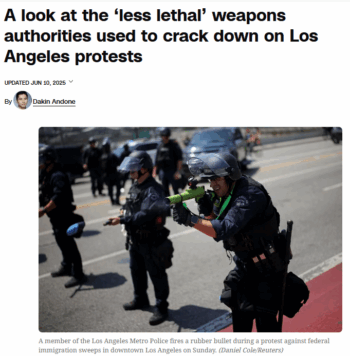
CNN (6/10/25) framed police munitions as the way cops “responded with force” after protests “devolved into violence.”
One CNN article (6/10/25) offered “A Look at the ‘Less Lethal’ Weapons Authorities Used to Crack Down on Los Angeles Protests.” Reporter Dakin Andone wrote:
Police have used a standard variety of tools to disperse crowds and quell protests that had devolved into violence, with protesters lighting self-driving cars on fire and two motorcyclists driving into a skirmish line of officers, injuring two. A Molotov cocktail was also thrown at officers, LAPD Chief Jim McDonnell alleged, condemning the “disgusting” violence.
Authorities have responded with force. So far, CNN has documented the deployment of flash-bangs, tear gas, pepper balls, rubber bullets and bean bag rounds, as well as more traditional gear such as batons.
To CNN, protesters devolve into “violence,” while heavily armed agents of the state respond with “force.”
The article noted that these weapons are not “harmless,” as they have been found to “disable, disfigure and even kill.” Projectiles are meant to cause “‘blunt-force trauma to the skin,’” chemical irritants cause “difficulty swallowing, chest tightness, coughing, shortness of breath and a feeling of choking,” and flash-bangs “obscure a target’s vision and hearing.”
Yet the article’s description of the effects of those weapons used in LA remained almost entirely theoretical. The only example it gave of a civilian targeted by one of these “less lethal” weapons was that of Australian 9News correspondent Lauren Tomasi, shot at close range by a rubber bullet while reporting on live TV. (Video footage shows that there was no one close to the line of officers, nor were any protesters closing in.) “The bullet left her sore, but she was otherwise unharmed,” CNN blithely noted.

While it’s good to see media standing up for those who were injured while exercising the freedom of the press (Guardian, 6/11/25), they might have shown similar concern for those hurt while engaging in freedom of assembly.
Meanwhile, Reporters Without Borders (6/11/25) has documented an astounding 35 violent attacks on journalists, almost entirely by law enforcement, including numerous reporters hit by police projectiles. The Guardian (6/11/25) reported that British photographer Nick Stern needed surgery when police shot him in the leg with a “less-lethal projectile”; Toby Canham, a photographer working for the New York Post, was “hit in the head by a less-lethal round” by a California highway patrol officer and “treated for whiplash and neck pain,” the Guardian said. (Protesters were injured by police munitions as well, as repeatedly attested by social media, but reporters showed less interest in those injuries.)
The headlines that reported the assault on Tomasi frequently left out the perpetrator: “Australian Reporter Covering Los Angeles Immigration Protests Hit by Rubber Bullet on Live TV,” was how CBS (6/10/25) put it; CNN (6/8/25) had “Australian Reporter Covering LA Protests Hit by Rubber Bullet.” The Sydney Morning Herald (6/9/25) described Tomasi as “caught in the crossfire as the LAPD fired rubber bullets at protesters”—which doesn’t sound like a “crossfire” at all.
Many reports denied the potential for these weapons to cause death by labeling them “non-lethal” (Guardian, 6/8/25, 6/11/25; AP, 6/9/25; LA Times, 6/10/25; USA Today, 6/10/25; Newsweek, 6/10/25) or “less-than-lethal” (New York Times, 6/6/25; NBC, 6/8/25). These descriptors are entirely inaccurate, as studies and reports have documented dozens of deaths caused by “less-lethal” projectiles, as well as hundreds of permanent injuries (BMJ Open, 12/5/17; Amnesty International, 3/14/23; Arizona Republic, 5/13/25).
Reuters (6/11/25) reported on attacks by such weapons under the headline “Journalists Among the Injured in LA as ICE Protests Grow Violent”—a framing that treated the protests as the source of the violence being inflicted on journalists by police.
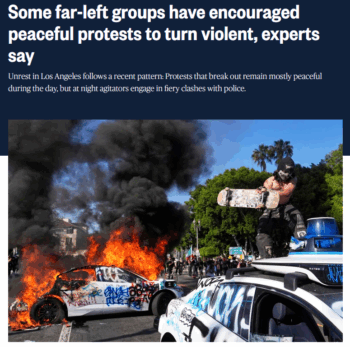
As an example of leftists who “encouraged peaceful protests to turn violent,” NBC News (6/12/25) included those who condemned police violence “using expletives and slights.” (Note that the skateboard-wielding protester is the same individual the LA Times—6/10/25—used to suggest “agitators” were “driving chaos.”)
A remarkable NBC News article (6/12/25) blamed protesters for fomenting violence by pointing out police violence. “Some Far-Left Groups Have Encouraged Peaceful Protests to Turn Violent, Experts Say,” was the headline; one of the few examples, under the heading “Assassination culture,” was:
One anti-police group, the People’s City Council Los Angeles, has taken to calling out the actions of officers at the protests, using expletives and slights.
Just before 1 a.m. Tuesday, it posted on X the name and picture of a police officer it said was firing rubber bullets at protesters.
He is “fucking unhinged and unloading on protesters at point blank range,” the post read. “FUCK THIS PIG!!”
Perhaps it was the cop firing rubber bullets at protesters at point blank range who “encouraged peaceful protests to turn violent”—and not the “expletives and slights” of the witnesses?
‘Diverted public attention’
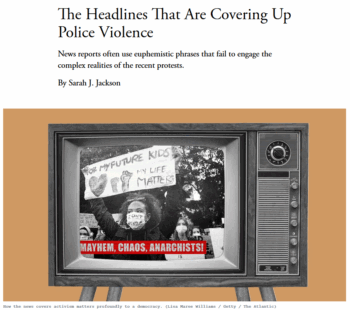
Sarah J. Jackson (Atlantic, 6/3/20): “When news stories employ sensational images of property damage, using terms such as riot and the even more sensational mayhem and chaos, researchers have noted a rise in public support for law-and-order crackdowns on protest.”
The New York Times editorial board (6/8/25), while critical of Trump’s National Guard deployment, opined that “protesters will do nothing to further their cause if they resort to violence.” The LA Times (6/10/25) expressed that “violence and widespread property damage at protests…have diverted public attention away from the focus of the demonstrations.” What has historically turned the tide against protests, however, is inflammatory reporting that blames protesters for their response to government’s aggressive efforts to suppress freedom of assembly (Penn State University, 6/1/01; Real Change, 3/18/09; Atlantic, 6/3/20).
By framing the problem as unruly demonstrators, the media lend legitimacy to the Trump administration’s attempt to set a precedent for military suppression of dissent. (“If there’s any protester that wants to come out, they will be met with very big force,” Trump said of the military parade he arranged to run through DC on June 14, his 79th birthday. “This is people that hate our country, but they will be met with very heavy force.”) Journalists should be focusing not on the broken windows, but on Trump’s very real efforts to break our democracy.
This content originally appeared on FAIR and was authored by Shirlynn Chan.